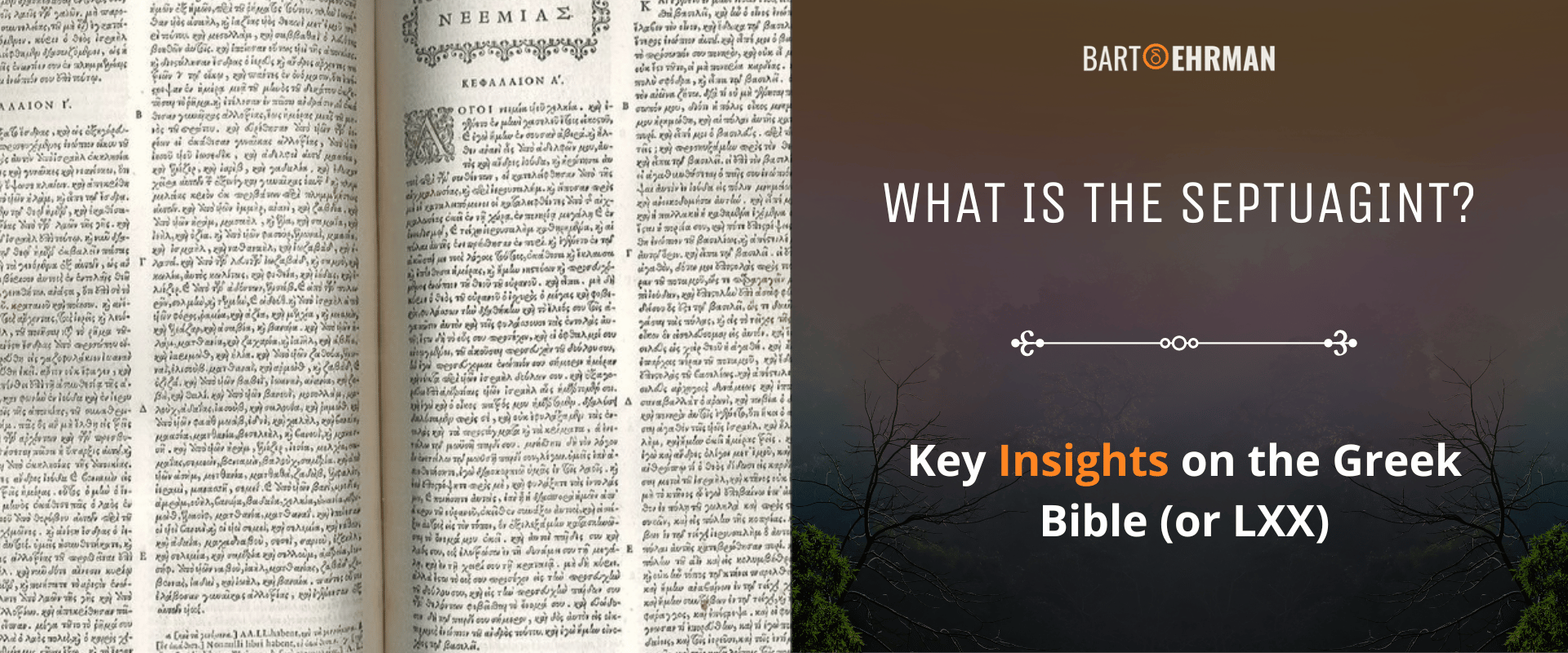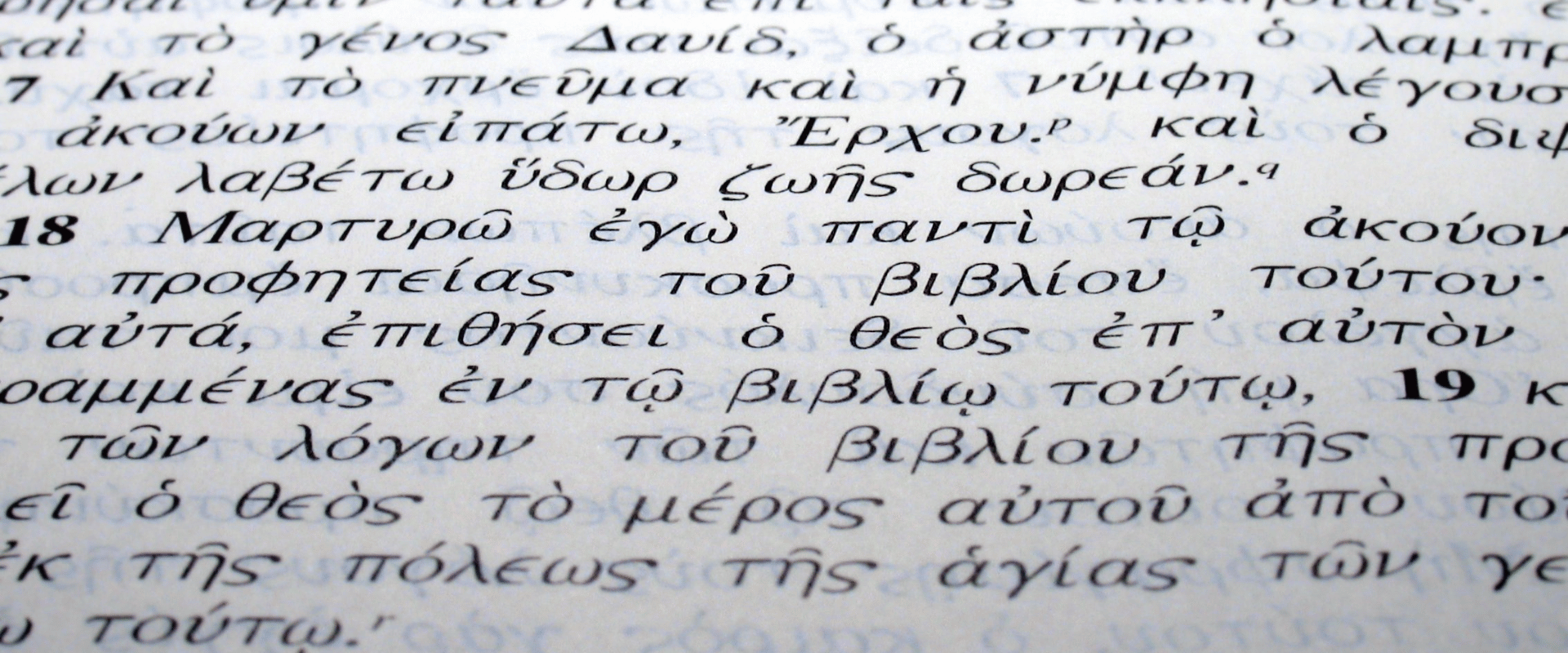Septuagint: Key Insights on the Greek Bible (or LXX)

Written by Joshua Schachterle, Ph.D
Author | Professor | Scholar
Author | Professor | BE Contributor
Verified! See our editorial guidelines
Verified! See our guidelines
Edited by Laura Robinson, Ph.D.
Date written: April 3rd, 2024
Disclaimer: The views and opinions expressed in this article belong to the author and do not necessarily match my own. - Dr. Bart D. Ehrman
The Septuagint, an ancient text written long before the New Testament, holds secrets that can challenge and deepen our understanding of early Christianity. It’s an extremely important biblical text, a Greek Bible translated from Hebrew. But there’s so much more to the story! In fact, you absolutely cannot understand the significance of the New Testament without knowing at least a little about the Septuagint.
Have I made you curious? Let’s dive into this text and its importance for Judaism, Christianity and the New Testament.

What is the Septuagint?
Let’s start off with the etymology of the name of this text: what is the definition of “Septuagint”? It comes from the Latin septuaginta meaning “seventy.” This in itself is a translation from the Greek word hebdomḗkonta which also means “seventy.” For this reason, its title is often abbreviated with the Roman numeral LXX (I’ll use both “Septuagint” and “LXX” interchangeably in this article). Why would a text be called “Seventy?” Glad you asked!
The Septuagint is in fact the earliest Greek version of the Hebrew Bible. Why Greek? As you may know, Alexander the Great and his armies swept through Europe and the Near East like a plague from 336-323 BCE, conquering every land they came to, including Palestine, and spreading Greek language and culture to those lands.
This is, for example, why the entire New Testament is written in Greek: it became the lingua franca, the common international language, in those lands.
For this reason, some Jews, especially those raised outside Palestine like the Apostle Paul, spoke Greek as their first language. This meant that having access to the Scriptures only in Hebrew could be a problem. They needed a Greek Bible (remember that until the 2nd century, only the Hebrew Bible counted as Scripture for both Jews and Christians).
With that as background, we come to the explanation of the name Septuagint. It is based on a legend – long discredited by scholars – about how and by whom the Hebrew Bible was translated into Greek.
According to Jennifer Dines, tradition says that a Greek ruler of Egypt named Ptolemy II Philadelphus, who ruled from 284-246 BCE, a century after Alexander had conquered Egypt, ordered either seventy or seventy-two (there are different versions) Jewish translators to translate the Hebrew Bible into Greek (this was long before the New Testament was written) so that he could include it in his library. Why seventy-two? The legend says that Ptolemy hired 6 translators from each of the 12 tribes of Israel.
The name Septuagint, then, comes from the number of translators in the legend. Incidentally, by the time of Ptolemy’s rule, the 12 tribes had long been dispersed after Israel’s defeat and conquest by the Neo-Assyrian Empire in 722 BCE. This is one reason scholars know the story is not historical.
This legend comes from several ancient sources. The earliest is a text called the Letter of Aristeas, a 3rd or 2nd century BCE text which claims to be a letter written from a Greek-speaking man named Aristeas to his brother Philocrates.
Most scholars today think the letter is pseudepigraphal, that is, ascribed to Aristeas but actually written by someone else. It seems to have been written with the goal of proving that the Septuagint is the best version of the Hebrew Bible, superior even to the Hebrew original.
The Babylonian Talmud, an ancient source of Jewish law, says in its version of the legend that each of the translators was placed in a separate room and told to translate the entire Hebrew Bible alone. Miraculously, divine inspiration caused all seventy or seventy-two translations to come out identical, validating the accuracy of the translation.
Several other ancient authors repeat this legend in their writings, including Jewish theologian and philosopher Philo of Alexandria (c. 20 BCE – c. 50 CE), Jewish historian Flavius Josephus (c. 37 – 100 CE), and much later, Christian theologian Augustine of Hippo (354-430 CE). None of this means the legend was true, but it does show that it was widely believed by ancient Jewish and Christian intellectuals.
But if this is just a legend, what can scholars tell us about the actual translation of the Septuagint?
FREE COURSE!
WHY I AM NOT A CHRISTIAN
Raw, honest, and enlightening. Bart's story of why he deconverted from the Christian faith.
Over 6,000 enrolled!
When and Where Was the Septuagint Made?
J.A.L. Lee notes that the style of Greek used in the LXX translation of the Pentateuch, the first 5 books of the Bible, argues for a date of translation around the 3rd century BCE in Alexandria, Egypt. We also have manuscripts from the 2nd century BCE, indicating that the Greek Pentateuch had been copied and circulated long before then.
Lee also writes that the rest of the books of the Hebrew Bible were translated gradually over the next two or three centuries, although Joel Kalvesmaki notes that it’s not entirely clear which books were translated when. Kalvesmaki also notes that there are variations in the style and quality of translations from book to book.
However, several stages of translation into Greek and eventually other languages can be generally identified according to Karen Jobes and Moises Silva. The initial Greek translation was completed by 132 BCE, more than a century before the birth of Jesus. This became the standard version used by later translators, including early Christian writers.
It was next translated into Latin according to Cornelia Linde and this is when it began to be called by its Latin name. The Greek version was also used as the source text for later translations into languages such as Coptic, Georgian, Slavonic, Armenian and Syriac.
What are the Contents of the Septuagint?
The language of the LXX was Koine Greek, the same language in which the entire New Testament was written. Henry Swete noted that within the Greek, the LXX also included some idioms that came originally from Hebrew or Aramaic (although they weren’t always understood or translated correctly).
In terms of content, William Ross writes that unlike our common conception of “The Bible,” the Septuagint is not one complete, cohesive text. It consists of various translations of the books of the Hebrew Bible made by many different translators at different times. It also includes some books of the apocrypha. This makes sense because we know that the Hebrew Bible canon evolved and changed over centuries, only becoming somewhat solid at the end of the 1st century CE.
Lawrence Schiffman also notes that in various manuscripts of the Septuagint from the 4th century CE, there are differences in content, with some manuscripts containing only broadly canonical books and others containing apocryphal books as well.
All of this demonstrates that the Septuagint changed over time, but also that it continued to change for centuries beyond the time of its initial translations.

How Did Jews and Christians Use the Septuagint?
As I said earlier, the Septuagint Bible was especially useful for Greek-speaking Jews who lived in the diaspora. Crawford Howell Toy and Richard Gottheil write that the Septuagint was generally accepted and used widely by Jews during the Second Temple period (597 BCE – 70 CE). However, after the Temple was destroyed by Rome in 70 CE, Rabbinic Judaism gradually rejected its use.
One reason for this is that the Septuagint and the original Hebrew Bible differed in many cases. The Rabbis understandably preferred the Hebrew source text to a translation in such cases. Toy and Gottheil also note that the Greek translations sometimes seemed unaware of the meaning of Hebrew idioms, leading to mistranslations.
An example of this is in Isaiah 7:14 in which the Septuagint translated the Hebrew word almah, meaning “young woman,” as “virgin.” This led to some well-known consequences for Christian theology.
Speaking of Christianity, scholars have known for a long time that all the New Testament authors used the Septuagint for their Hebrew Bible references (although not exclusively). In some cases, this led to highly (perhaps unintentionally) meaningful mistranslations. This includes Matthew’s reference to Isaiah 7:14 mentioned above, a prophecy which the Gospel author uses to argue that Jesus was born to a “virgin” rather than a “young woman.”
The vast majority of quotations from the Hebrew Bible used in the New Testament were taken from the Septuagint. However, Jerome, who translated the Bible into Latin in the 4th and 5th centuries CE, found several Hebrew Bible quotations in the New Testament – Matthew 2:15, Matthew 2:23, John 19:3, John 7:38, and 1 Corinthians 2:9 – that could only be located in Hebrew texts and not in the Septuagint. This indicates that the Gospel writers and Paul may have had access to both the Septuagint and the Hebrew versions in some cases.
Leonard Greenspoon notes an interesting example of this. In Acts 15, there is a debate about whether Gentile Christians need to be circumcised. During the debate, James, the brother of Jesus and a key leader in the early Church, cites a passage from the Hebrew Bible. Greenspoon writes that
The first part of this citation “I will rebuild the dwelling of David, which had fallen” is clearly a reference to Amos 9:11 in the traditional Hebrew wording… “I will raise up the booth of David that is fallen.” The next line in Acts, “so that other peoples may seek the Lord,” is very different from the [Hebrew text which says] “in order that they may possess the remnant of Edom.”
Again, it seems that in some cases, the Hebrew version and the Septuagint were both used, even within the same quotation. However, I must again emphasize that almost all of the Hebrew Bible references in the New Testament come from the Septuagint which Christians came to view as the most authoritative version of the text.
To this day, the Eastern Orthodox Church uses the Septuagint version of the Old Testament, rather than the Hebrew version, as its original source for translating the Hebrew Bible into all other languages.
Did You Know?
Greenspoon notes that in the 1st century when the New Testament was being written, very few people owned books or scrolls. Biblical passages, then, would often be learned and transmitted orally.
While it is possible that some of the New Testament authors had both Hebrew and Greek versions of the Hebrew Bible in front of them for comparison, most of those passages would have been learned through hearing them over time.
Those authors who were Jewish, depending upon where they came from, might have heard both Greek and Hebrew versions of some of the texts they quoted. If so, Greenspoon thinks it’s possible that each author simply chose the version of each quotation – or part of a quotation – that most benefited their arguments.
Conclusion
What is the Septuagint? It is an enormously significant book for the history of the Bible. By definition, the Septuagint is the Greek translation of the Hebrew Bible, made for those Jews (and others) who were unable to read biblical texts in their original Hebrew since their first language was Greek.
Its name, meaning “seventy,” came from a legend, preserved in ancient texts, which said that a Greek Pharoah in Egypt ordered either seventy or seventy-two Hebrew scribes to translate the Hebrew Bible into Greek. Although each translator was isolated from the others, they all, through divine inspiration, created the exact same translations. While this was widely believed for centuries, scholars have long ago dismissed it as a myth.
The actual process of translating the Hebrew Bible into Greek took centuries. The earliest translations, made in the 3rd or 2nd centuries BCE, contained only the Pentateuch. Over the next two or three centuries, the rest of the Scriptures, including apocryphal books, were translated as well.
Jews of the Second Temple period accepted the validity of the Septuagint. However, with the rise of Rabbinic Judaism after the destruction of the Jerusalem Temple, the Septuagint gradually fell out of favor with Jews.
Christians, on the other hand, seem to have used the Septuagint Bible extensively, as attested by the authors of the New Testament. While there are quotations found in the New Testament that come from the Hebrew original only, the majority come from the Septuagint, which was used for centuries afterwards by Christian authors.
FREE COURSE!
WHY I AM NOT A CHRISTIAN
Raw, honest, and enlightening. Bart's story of why he deconverted from the Christian faith.
Over 6,000 enrolled!
